Cutting-edge science and technology in the last 12 months
Researchers from all areas of knowledge at the Universidad Nacional Autónoma de México continued to add knowledge, talent, and creativity. Proof that their work has not stopped is the scientific research and technological developments presented by the members of this community in the last 12 months.

Scientists from all areas of knowledge at the National Autonomous University of Mexico continued to add knowledge, talent, and creativity, despite the second year of the COVID-19 pandemic. The scientific research and technological developments presented by the members of this community in the last 12 months are proof that their work has not stopped.
Specialists from the Institute for Research in Applied Mathematics and Systems and the Center for Complexity Sciences (C3) created a mathematical model that could reduce traffic and congestion in Mexico City by up to 40 percent by implementing adaptive reversible lanes on primary roads.
Using must or juice from grapes and their skins from the cheese and wine industries, experts from the Institute of Engineering, Juriquilla Unit, obtain hydrogen and methane, biofuels useful for generating electricity in a clean process.
Researchers from the Institute of Biotechnology and INMEGEN led the largest study of the complete genome of populations native to Mexico, which offers a significant amount of information and will allow advances in medical and population studies in our country.
Experts from FES Cuautitlán created a garambullo soft drink with high nutritional value and sweetened with agave honey with high levels of antioxidants and vitamin C; in addition to a vegetable milk made with chickpea seeds to combat high cholesterol levels; it improves intestinal health and contributes to proper glucose utilization and control.
With a steel plaque, the Institute of Geophysics declared the extinction of the Ayoloco glacier, at the summit of the Iztaccihuatl volcano, whose absence impacts the availability of water and climate regulation. The inscription reads "To future generations: Here the Ayoloco glacier existed and retreated until it disappeared in 2018. In the coming decades, Mexican glaciers will disappear irretrievably. This plaque is to put on record that we knew what was happening and what needed to be done. Only you will know if we did it.
University students are promoting the first Mexican Lupus Registry, whose purpose is to generate reliable statistics on the number of people suffering from this disease in our country, in addition to uniting this community that requires medical and emotional support.
The University participates in an international initiative of 15 institutions from Europe and America, which investigates how primates move and make decisions to get their food more efficiently and includes the three species that live in Mexico and are at risk of extinction.
Researchers at the Institute of Biomedical Research discovered a genetic mutation called AKT1-E17K, which promotes cell proliferation and thus the growth of breast cancer tumors, which affects eight percent of women in Latin America.
With unique algorithms and technology, UNAM, together with 70 institutions around the world, began scientific operations for the DESI spectroscopic census of galaxies, never done before, which will form the most precise three-dimensional map of the Universe.
Compared to women, men have more cardiovascular problems and are more affected by viruses such as SARS-CoV-2, which causes COVID-19, because both organisms function differently, reveals a study carried out by experts from the Center for Complexity Sciences, presented in the journal Frontiers in Physiology.
An electronic nose that detects whether a person is healthy or in the initial stages of a disease is being developed at the Institute of Applied Sciences and Technology and the Spanish National Center for Scientific Research. The device has sensors based on nanomaterials and fits in the palm; it is tested for the non-invasive diagnosis of cancer, asthma, and chronic obstructive pulmonary disease.
Joel Sánchez Bermúdez, from the Institute of Astronomy, participated with an international team of experts to reveal that the star Betelgeuse lost part of its brightness 70 years ago because it was hidden by a cloud of dust, which solves one of the great astronomical mysteries. The work, presented in the journal Nature, was carried out with the Very Large Telescope in Chile.
UNAM participated in the high-level meeting of the University Climate Change Coalition, which brings together more than 20 leading North American research universities.
The Miztli supercomputer was one of six computers used to recreate a galaxy similar to the Milky Way as part of the international Assembling Galaxies of Resolved Anatomy (AGORA) project.
Iztli 1, a peptide developed at the Institute of Cell Physiology, patented in Mexico, could become an antibiotic to combat tuberculosis.
The Institute of Cell Physiology identifies cells that facilitate recovery from cerebral infarction. Astrocytes, of utmost importance for the brain, could be the key to the restoration of this organ after a person has a stroke.
Experts from the Institute of Biotechnology at Stanford University in the United States and the Salvador Zubirán National Institute of Medical Sciences and Nutrition discovered, isolated, and synthesized two new antibiotic molecules from scorpion venom.
Researchers at the Facultad de Estudios Superiores Cuautitlán created microspheres to protect the active ingredients for oral administration of drugs, while at the Instituto de Química they created a formulation with scorpion venom that prevents metastasis, i.e., the spread of cancer.
Technology
The National University is the institution of higher education with the most patents granted by the Mexican Institute of Industrial Property in the last year and a half, with a total of 73; it also occupies the first place in the list of applications made by houses of study before the public organism.
At the end of the year, experts from the High Technology Unit of the School of Engineering in Juriquilla will test the K'OTO nanosatellite in Japan, which will take photographs of the national territory.
In the Faculty of Sciences, they designed technology to achieve better magnetic resonance images, with greater resolution and scope than at present.
The Radiopharmacy-Cyclotron Unit of the School of Medicine will make available to hospitals and physicians a new radiopharmaceutical based on Fluorine 18, which is more economical, durable, and efficient for the diagnosis of neuroendocrine tumors.
Scientists from the Facultad de Estudios Superiores Cuautitlán are developing a transdermal patch with biodegradable polymeric hollow microneedles, which release sodium alendronate, a method that will reduce the adverse reactions of one of the drugs used to treat osteoporosis, particularly in postmenopausal women and older men.
NASA tested in suborbital flight devices created by UNAM and IPN researchers, key pieces for the construction of a CubeSat type nanosatellite.
The Institute of Cell Physiology developed video games for the telerehabilitation of patients who have suffered neurological damage as a result of a stroke or cerebral infarction.




